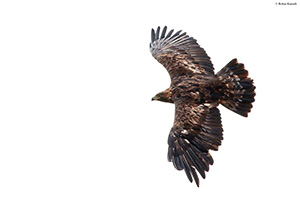|
|
Golden Eagle
Aquila chrysaetos |
|
|
STANFORD LOCATIONS: Rare informal sightings of juvenile on the back of the dish area. |
 |
Location |
Type |
Mating System |
Parental Care |
2ndary Diet |
Strategy |
|
|
|
|
I: 43-45 DAYS SEMIALTRICIAL 1 |
|
|
|
10 feet - 100+ feet |
|
(1-4) MONOG |
MF |
REPTILES INSECTS |
|
| BREEDING: | Open habitats, esp in mountains and hills. 1 brood. |
| DISPLAYS: | Upward spiral then nose-dive, wings half open, gliding up then diving and calling, usu alone, occ in pairs. |
| NEST: | Sticks interwoven with brush, leaves, etc. Lined with fine materials. Often 2-3 (occ more) nests used alternately; perennial, becoming very large. |
| EGGS: | White/cream-buff, marked with brown; 1 egg usu unmarked. 2.9" (75 mm). |
| DIET: | Esp jackrabbits; other prey (including carrion) when mammals scarce. |
| CONSERVATION: | Winters s to n Mexico highlands. Protected since 1962 after >20,000 destroyed in 10 years mostly by sheep ranchers in spite of little evidence of livestock depredation; now stable or increasing. Also subject to powerline electrocution, poison intended for coyotes, etc. |
| NOTES: | Long-term pair bond. Male captures more food than female during incubation and chick rearing; male feeds female on nest, rarely feeds young directly or broods. Male incubates small amount, only in day. Oft use aromatic leaves in nest to deter insect pests. Larger sibling oft kills smaller. In most of w, territories occupied year-round. Subadult birds occ breed. Hunt solo or in pairs. Occ roost communally in winter when prey densities high. |
| ESSAYS: | DDT; Brood Reduction. |
| REFERENCES: | Beecham and Kochert, 1975; Collopy, 1984; Cramp and Simmons, 1980; Steenhof et al., 1983. |
| Help | Abbreviations | Species-Alphabetical | Species-Taxonomic | Essays-Alphabetical | |
| Except for Stanford Locations, the material in this species treatment is taken, with permission, from The Birder's Handbook (Paul Ehrlich, David Dobkin, & Darryl Wheye, Simon & Schuster, NY. 1988). | |||||